新鲜和完全蚀变岩石的物理力学行为是El Rosario帝王蝶保护区边坡失稳的重要因素,Michoacán,墨西哥
IF 0.5
4区 地球科学
Q4 GEOSCIENCES, MULTIDISCIPLINARY
Revista Mexicana De Ciencias Geologicas
Pub Date : 2021-11-29
DOI:10.22201/cgeo.20072902e.2021.3.1674
引用次数: 1
摘要
墨西哥米却肯蝴蝶生物圈保护区(RBMM)的斜坡不稳定是一种普遍存在的现象,是气候、斜坡和不同岩石单元的空间分布等不同因素之间复杂相互作用的结果。气候为温带亚湿润气候,夏季有降雨,年平均降雨量为700至1250毫米。该地区的主要地貌单元为火山山,坡度大于30度。本研究的主要范围是通过实验室测试(体积密度、渗透性、孔隙率、单轴抗压强度)来表征Angangueo山脉(Cerro El Campanario,El Rosario省,Michoacán)新鲜和完全蚀变的下中新世安山岩熔岩的物理力学性质。新鲜岩石样品的总孔隙度、渗透率和UCS值分别为0.262 mD、17.1%和63.5 MPa。相反,蚀变岩石显示出393.71 mD、60.9%和0.26 MPa的值。我们的研究结果表明,边坡和蚀变引起的岩石性质退化是该地区不稳定的条件因素。非典型降雨可能是边坡破坏的触发机制。本文章由计算机程序翻译,如有差异,请以英文原文为准。
Physical-mechanical behavior of fresh and completely altered rocks as an important factor of slope instability in the El Rosario Monarch Butterfly Sanctuary, Michoacán, Mexico
Slope instability in the Butterfly Biosphere Reserve (RBMM) Michoacán, Mexico, is a widespread phenomenon that results from the complex interaction among different factors such as climate, slope, and the spatial distribution of different rock units. The climate is temperate subhumid, with rains in summer and an annual average rainfall of 700 to 1250 mm. The main physiographic units of the area are volcanic mountains, with slopes greater than 30 degrees. The main scope of this study is to characterize the physical-mechanical properties of fresh and completely altered lower Miocene andesitic lavas of the Sierra de Angangueo (Cerro El Campanario, province of El Rosario, Michoacán) by implementing laboratory tests (bulk density, permeability, porosity, uniaxial compressive strength). The fresh rock sample presents total porosity, permeability, and UCS values of 0.262 mD, 17.1 %, and 63.5 MPa, respectively. Instead, the altered rock display values of 393.71 mD, 60.9 %, and 0.26 MPa. Our results suggest that the slope and the degradation of the rock properties induced by alteration are the conditioning factors of instability in the region. Atypical rainfalls may act as triggering mechanism for slope failure.
求助全文
通过发布文献求助,成功后即可免费获取论文全文。
去求助
来源期刊

Revista Mexicana De Ciencias Geologicas
地学-地球科学综合
CiteScore
1.00
自引率
12.50%
发文量
0
审稿时长
6-12 weeks
期刊介绍:
Revista Mexicana de Ciencias Geológicas (RMCG) publishes original research papers on geological processes of broad interest, and particularly those dealing with regions of Latin America. The RMCG also publishes review papers on topics of current interest, and on the geology and tectonics of geological provinces of Latin America. Besides, it offers the opportunity for host editors to publish special thematic issues.
 求助内容:
求助内容: 应助结果提醒方式:
应助结果提醒方式:


